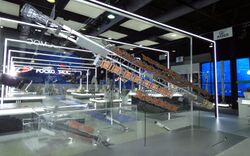Engineering:TEM (nuclear propulsion)
| Transport and Energy Module (TEM) | |
|---|---|
 | |
| Generation | Generation IV |
| Reactor concept | Gas-cooled reactor (GCR) |
| Designed by | Keldysh Research Center Rosatom Roscosmos NIKIET institute |
| Manufactured by | Keldysh Research Center NIKIET institute |
| Status | Under development |
| Main parameters of the reactor core | |
| Fuel (fissile material) | Information missing |
| Fuel state | Solid |
| Neutron energy spectrum | Thermal |
| Primary coolant | helium 78% - xenon 22% [1] |
| Reactor usage | |
| Primary use | Generation of electricity for propulsion |
| Power (thermal) | 3.8 MW |
| Power (electric) | 1 MWe (BWR-1) |
TEM (Russian: Транспортно-энергетический модуль, "transport and energy module\unit", NPPS in English) is an under development nuclear propulsion spacecraft with the intention to facilitate the transportation of large cargoes in deep space.[2] It will be constructed by the Russian Keldysh Research Center,[3] NIKIET (Research and Design Institute of Power Engineering) institute,[4] and Rosatom.
Mission
A Russian project to create an uncrewed nuclear electric rocket spaceship for Solar system exploration. The first reactor tests are scheduled for the early 2020s; as of May 2020, the first orbital flight test of the reactor is planned for no earlier than 2030.[3] The first mission, named Zeus, is envisioned to operate for 50 months and deliver payloads to the Moon, Venus, and Jupiter through multiple gravity assists.[5]
Specifications
Reactor
Spacecraft
- Mass: 20,290 kg (limited by Angara 5 carrying capacity)
- Thrust: 18 N
- Specific impulse: 7000 s
- Space-launch vehicle: Angara
Project history
- 2009 – Project started.
- March 2016 – First batch of nuclear fuel received[citation needed]
- October 2018 – Successful initial tests of the water droplet radiator system[citation needed]
- May 2021 – Zeus mission proposed by Roscosmos and the Russian Academy of Sciences
See also
References
- ↑ Ядерные реакторы в космосе: ТЭМ
- ↑ "Russian Space Agency confirms plans to launch nuclear-powered space tug by 2030". SpaceDaily. 29 January 2020. https://www.spacedaily.com/reports/Russian_Space_Agency_confirms_plans_to_launch_nuclear_powered_space_tug_by_2030_999.html. Retrieved 29 June 2020.
- ↑ 3.0 3.1 "Рогозин посчитал перспективы создаваемого ядерного буксира гигантскими" (in ru). TASS. 27 May 2020. https://tass.ru/kosmos/8583197. Retrieved 29 June 2020.
- ↑ "DailyTech - Russia is Developing Nuclear Fission Spaceship to Reach the Red Planet". Archived from the original on 20 August 2017. https://web.archive.org/web/20170820162117/http://www.dailytech.com/Russia+is+Developing+Nuclear+Fission+Spaceship+to+Reach+the+Red+Planet/article16662.htm. Retrieved 20 August 2017.
- ↑ "First mission of Russia's nuclear-powered space tug to take 50 months". TASS. 22 May 2021. https://tass.com/science/1292721.
External links
 |

